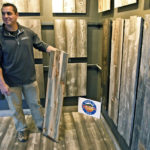Forests and trees: Montana’s timber culture keeps evolving
Posted: December 4, 2016Source: Ravalli Republic

Photo from Tom Bauer – Ravalli Republic
A 2-by-4 no longer measures 2 inches by 4 inches.
And a sheet of plywood? They used to come out of the world’s largest mill in Bonner, Montana, measuring 4 feet by 8 feet by half an inch. Now an Oregon company produces sheets 12 feet wide, 48 feet long and 2 feet thick. They compete with concrete slabs for skyscraper construction.
I started putting together this series on Montana’s timber industry back in July when my new-to-Montana editor asked a simple question. With trees everywhere on the horizon, why can’t our local sawmills find enough wood to cut?
Over the last seven days, the Missoulian has tried to gather the stories of the people who lived through the “Timber Wars” that closed out the 20th century, with the hope of illuminating what the future timber industry might look like. In what we sometimes call the “dead-tree” printed version of the newspaper, the project has filled 508 column-inches of newsprint.
Anyone who’s tried to replace an old 2×4 with one of the new planks that measure 1 ½ x 3 ½ knows past isn’t always prologue. Likewise, the forests we fought about between World War II and 2000 might bear little resemblance to the trees of the 21st century.
Consider some new ways we think about wood:
• On Nov. 14, Alaska Airlines flew a passenger jet from Seattle to Washington, D.C. on a tank of 20 percent biofuel made from wood pulp.
• Consumer spending on outdoor recreation in Montana totaled $5.8 billion annually, according to the Outdoor Industry Association. That produced 64,000 direct jobs in the state and $1.5 billion in wages (not including spending or jobs from hunting, fishing or wildlife watching). The state’s timber industry now employs about 7,500 workers who earned $330 million.
• One of Missoula’s biggest wood products businesses employs 40 people who hand-surface, dye and shape the wood into flooring and paneling. The customers of Ryan Palma’s Sustainable Lumber Co. particularly demand beetle-killed pine, preferring its exotic blue hues.
“The industry’s changed a lot in the last 20 years,” said Palma, who many Missoulians remember as the University of Montana Grizzly football free safety in the 1995 national championship team. “I used to sell boxcars of lumber to distributors, who sold it to retailers, who sold it to builders. Now I’m the largest producer of fir flooring in the world, and it’s a 100 percent made-in-Montana product.”
Technology also has changed the way we measure wood. A 2010 Forest Products Journal study written by UM researchers Chuck Keegan, Todd Morgan and colleagues could drive statistics majors to burn their pencils. Put simply, the report shows that the way we traditionally estimate the amount of timber in a log wildly diverges from the amount of lumber coming out of a sawmill.
In Montana’s case, the “lumber overrun” increased from 30 percent in the 1970s to 100 percent in the 2000s. In other words, for every estimated board-foot of tree going into the mill today, two board-feet come out.
“U.S. wood product & log measurements are really convoluted,” Morgan confesses. “If only we used the metric system, things could be a lot less complicated & confusing.”
The confusion grows from the evolution of sawmill technology. Over time, more efficient saw blades produced less waste and cut skinnier trees. Mills like the F.H. Stoltze Land and Lumber Co. in Columbia Falls use computer imagery to cut straight boards out of curved logs that might have been rejected a generation ago.
The jobs have changed as well. Mechanized harvesters allow one logger to do the work of 20 in the forest, from the comfort of a climate-controlled cab with satellite guidance and Bluetooth entertainment.
Palma’s company employs just one or two loggers who cut trees on order and send them to a Mennonite community for the hand-finishing work. Ninety percent of his inventory ships out of state.
But while he may need a single beetle-killed Ponderosa pine for a custom table order, Palma said he depends on Montana’s existing 10 large sawmills for the hundreds of thousands of board-feet of Douglas fir he uses for flooring. Last Wednesday, he loaded seven pallets of finished fir into a Fed Ex truck for delivery to an internet start-up company in Brooklyn, New York.
“A lot of the lumber industry is a dinosaur, not willing to change,” Palma said. “We’re doing things nobody in the lumber industry was doing. I’m building a 3-D showroom on the website so people can virtually walk through and see everything we have. It builds validity that we’re a real company – not some internet broker.”
